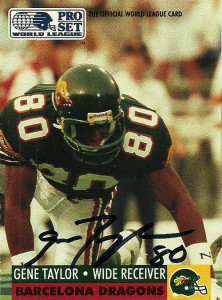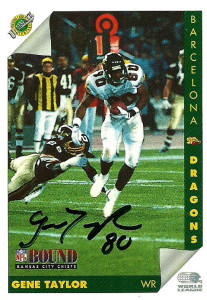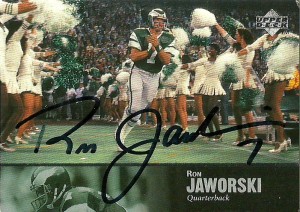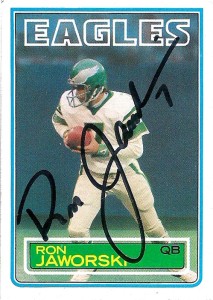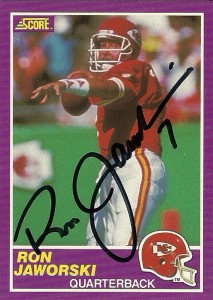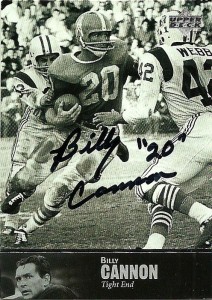Cards: ProSet WLAF 1991, Ultimate 1992, Ultimate WLAF Dragons card, Photo memorabilia
Acquired: TTM 2013, C/o work
Sent: 8/1 Received: 8/19 (18 days)
Gene Taylor is a member of the ‘Fresno State connection’. Among the colleges that contributed players to the WLAF, the Bulldogs sent more than any other college to the young World League back in 1991. Head coach Jack Bicknell was looking for a long bomb specialist for the Barcelona Dragons. He’d select Gene near the top of round 1 in the league’s positional draft. Gene didn’t disappoint, opening up the season with an electrifying 43 yard TD, en route to the team’s 19-7 thrashing of the New York-New Jersey Knights. Taylor saved his best game though for a contest against the Orlando Thunder however, when he caught 5 passes for 163 yards and 2 touchdowns, -including barn burners from 56 and 81 yards. To put things in perspective: By season’s end, Taylor’s yards alone consisted of 35% of Scott Erney and Tony Rice‘s combined passing yardage totals. Gene finished the 1991 season 2nd in the league in YPR, and 4th in both receiving yards and touchdowns, helping the Dragons make an appearance in World Bowl I. He’d be awarded with First Team 1991 All World Honors from the league, and was among the first WLAF players to sign a contract, after the season with the NFL.
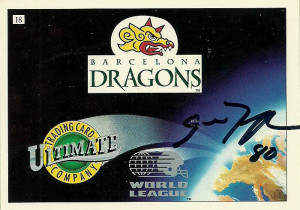 Gene was originally a 6th round draft choice of the New England Patriots in 1987, but not make the final roster. Instead he’d be signed by the Tampa Bay Buccaneers, where he’d stay through the 1988 season, recording 7 receptions for 74 yards in 12 contests. He’d sign with the 49ers in 1989, but head up to the CFL to play for the Saskatchewan Roughriders later that year. Gene returned to the NFL with the Los Angeles Rams in 1990, before being drafted by the Dragons in the WLAF. After his stop in the World League, Gene signed again with the team that originally drafted him, the New England Patriots in 1991. He’d suit up for 1 game that season but not see any significant game time.
Gene was originally a 6th round draft choice of the New England Patriots in 1987, but not make the final roster. Instead he’d be signed by the Tampa Bay Buccaneers, where he’d stay through the 1988 season, recording 7 receptions for 74 yards in 12 contests. He’d sign with the 49ers in 1989, but head up to the CFL to play for the Saskatchewan Roughriders later that year. Gene returned to the NFL with the Los Angeles Rams in 1990, before being drafted by the Dragons in the WLAF. After his stop in the World League, Gene signed again with the team that originally drafted him, the New England Patriots in 1991. He’d suit up for 1 game that season but not see any significant game time.
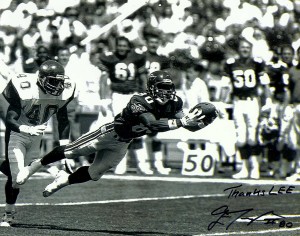 I was really happy to finally find Gene, thanks to a podcast by (a Raider faithful fan) RaiderGreg who did an interview with him about Taylor’s time in the leagues and also the player’s strike. RaiderGreg was more than happy to refer me to him, and after receiving my cards at the fire station where Taylor is a chief at, Gene was accommodating enough to sign the cards and also enclosing the additional piece of signed memorabilia. We chatted through email where amazingly, Taylor revealed that he had never seen his Ultimate WLAF card, probably since it was printed after his departure back to New England in 1991. That’s 20+ years. I’ll probably buy and send out a few more to Gene to keep since he probably had given out the fair majority to his coworkers. I must admit, he was incredibly patient with me through our correspondence, considering I tend to ramble on about things I am excited to talk about, but it seems that after responses from guys like Gene and other players, 2013 is shaping up to be a great year TTM.
I was really happy to finally find Gene, thanks to a podcast by (a Raider faithful fan) RaiderGreg who did an interview with him about Taylor’s time in the leagues and also the player’s strike. RaiderGreg was more than happy to refer me to him, and after receiving my cards at the fire station where Taylor is a chief at, Gene was accommodating enough to sign the cards and also enclosing the additional piece of signed memorabilia. We chatted through email where amazingly, Taylor revealed that he had never seen his Ultimate WLAF card, probably since it was printed after his departure back to New England in 1991. That’s 20+ years. I’ll probably buy and send out a few more to Gene to keep since he probably had given out the fair majority to his coworkers. I must admit, he was incredibly patient with me through our correspondence, considering I tend to ramble on about things I am excited to talk about, but it seems that after responses from guys like Gene and other players, 2013 is shaping up to be a great year TTM.
WLAF Rec 35 Yds 745 Avg 21.3 Td 6 Lg 81t
